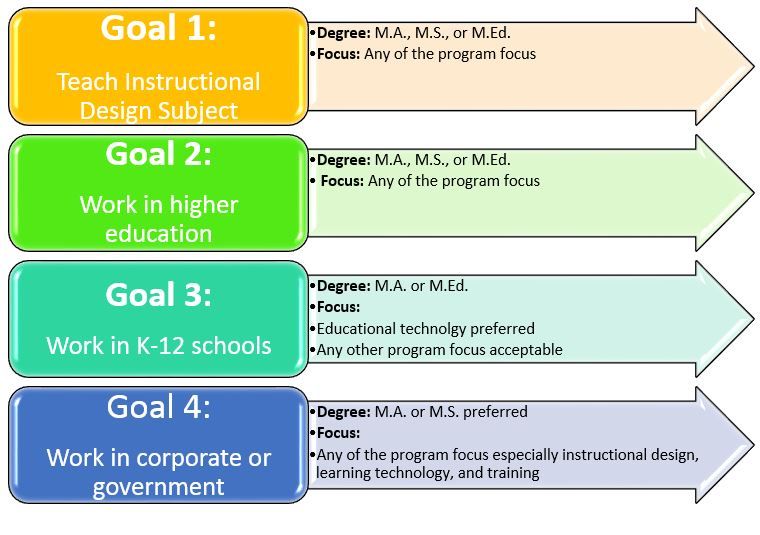-
Partner Services
- Curriculum Design & Development
- Faculty Development
- Instructor Staffing Services
-
Case Studies
- Colleges and Universities
- Columbus Council on World Affairs
- Nationwide
- Ohio Society of CPAs
- Supreme Court of Ohio Judicial College
- Degrees & Certificates
-
About Us
- Our Team
- Blog Archive
Categories
Authors
Archived Articles

How to Select an Instructional Design Master’s Program – List #1
Instructional design jobs are continuously becoming more in demand. The Bureau of Labor Statistics predicts that by the year 2022, jobs in instructional design are expected to increase by 15 percent. Most of these positions either require or prefer a master’s degree. Getting a master’s degree is thrilling. Searching for the best program and school that meets your needs is exciting and daunting. If you are shopping for an instructional design master’s program, first of all, consider your needs and goals. To help you out, try answering the questions in the following list, LIST #1: My Needs and Goals.
LIST #1: My Needs and Goals
- What are my career goals?
- Why do I need a master’s degree?
- What are my career path after earning my master’s degree?
- What’s the salary range with my master’s degree in instructional design?
Things to consider as you prepare your answers to the LIST #1.
There are multiple benefits of getting a master’s degree. You will not only gain a valuable addition to your resume, but also a deeper understanding and application of instructional design theories, models, and systems. However, you have to determine your career goals first. Do you want to teach instructional design as a subject? Do you want to work as an instructional designer in higher education? Or do you want to work in corporate and government as an instructional designer or trainer? Having a clear career goal is the first step to narrowing down the program that best fits your needs.
Another critical thing you need to consider before you invest your time and money in education is the types of jobs or positions you can get. Positions that graduates of an instructional design program could expect to obtain include:
- Courseware Developer
- Curriculum Specialist
- Director of Training/Learning
- Distance Learning Specialist
- E-Learning Development Manager
- Education Technologist
- Human Resources Generalist
- Instructional Design Analyst
- Instructional Design Specialist
- Instructional Designer
- Instructional Specialist
- Instructional Systems Designer/Specialist
- Instructional Technologist
- Instructional Technology Project Manager
- Knowledge Solutions Designer
- Learning Architect
- Learning Consultant
- Learning Specialist
- Performance Analyst
- Performance Consultant
- Performance Support Specialist
- Performance Technologist
- Training and Development Manager
- Training and Development Specialist
Of course, with a master’s degree, you should expect a salary increase or at least to negotiate a salary change. Association of Talent Development Research publishes their salary survey for talent development professionals where you can review the salary range for an instructional designer with a master’s degree. (Note: In many corporations, instructional design is considered a talent development or human resources function). The eLearning Guild not only conducts an annual U.S. eLearning Salary & Compensation report but also provides a salary calculator.
The next big question you need to ask yourself is what program is the right one for me? To answer this question, you may have to consider the following:
Which Program Degree Should I Get?
Currently there are three degree programs available in instructional design:
- Master of Education (M.Ed)
- Master of Arts (M.A.)
- Master of Science (M.S.)
The M.Ed. program is specifically designed for classroom teachers, educators, and administrators who want to increase their understanding of the role of technology and its appropriate implementation in the teaching and learning process. The difference between M.A. & M.S. programs are very minimal. The M.A. program may require a creative project, internship, or practicum as their capstone requirement while M.S. program may require a thesis or a research-based project.
Which Program Focus Should I Choose?
Instructional design master’s programs offered by different universities have various focuses. The program focuses include but are not limited to:
- Instructional design
- Instructional design and learning technology
- Learning design and learning
- Instructional design and learning sciences
- Instructional technology
- Educational technology
- Instructional systems design
- Instructional design and training
Now let’s go back to your career goals to map out the program degree and focus that are right for you. Check out the image at the beginning of this article.
In my next blog, I will share the list of criteria to help you review and narrow down specific programs to determine THE RIGHT program that meets your needs. Stay tuned for LIST #2: Program Selection Criteria.
Franklin University’s Instructional design and learning technology master program has been recommended in eLearning industry, ID Hunter, and the eLearning coach’s guides regarding instructional design and eLearning programs.
About the Author
Yi YangDr.
Copyright 2025 Franklin University